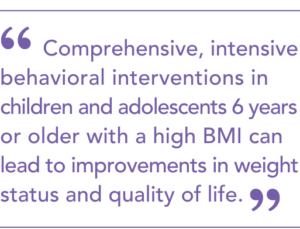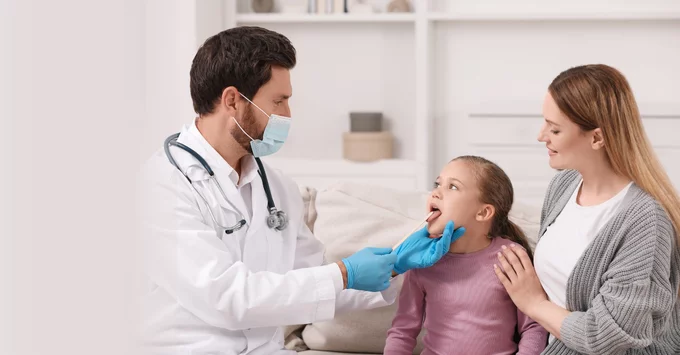by JoAnn Gurenlian, RDH, MS, PhD, AAFAAOM, FADHA
June 18, 2024
Recently, the U.S. Preventive Services Task Force (USPSTF) published a recommendation related to interventions for high body mass index (BMI) among children and adolescents. It is estimated that almost 20% of children and adolescents between the ages of 2 to 19 years in the U.S. have a BMI at or above the 95th percentile for age and sex based on the Centers for Disease Control and Prevention growth charts from 2000.1,2 The prevalence of high BMI increases with age, children and adolescents from lower income families, and among certain groups such as Hispanic/Latino, Native-American/Alaska Native, and non-Hispanic Black children.1,2
 In their review of studies related to this topic, the USPSTF found adequate evidence that comprehensive, intensive behavioral interventions in children and adolescents 6 years or older with a high BMI can lead to improvements in weight status and quality of life resulting in a moderate net benefit. The behavioral interventions should include at least 26 hours or more of supervised physical activity sessions with multiple components. Sessions are designed to target both the parent and child (separately, together, or both) and group sessions in addition to individual or single-family sessions. Information provided includes healthy eating, safe exercising, reading food labels, and behavioral change techniques such as problem solving, monitoring diet and physical activity behaviors, and goal setting. The comprehensive interventions are often delivered by teams of experts including pediatricians, exercise physiologists, physical therapists, dietitians, psychologists or social workers, or other behavioral specialists.
In their review of studies related to this topic, the USPSTF found adequate evidence that comprehensive, intensive behavioral interventions in children and adolescents 6 years or older with a high BMI can lead to improvements in weight status and quality of life resulting in a moderate net benefit. The behavioral interventions should include at least 26 hours or more of supervised physical activity sessions with multiple components. Sessions are designed to target both the parent and child (separately, together, or both) and group sessions in addition to individual or single-family sessions. Information provided includes healthy eating, safe exercising, reading food labels, and behavioral change techniques such as problem solving, monitoring diet and physical activity behaviors, and goal setting. The comprehensive interventions are often delivered by teams of experts including pediatricians, exercise physiologists, physical therapists, dietitians, psychologists or social workers, or other behavioral specialists.
In their review of the supportive evidence, the USPSTF, did not find evidence that behavioral interventions resulted in additional stigma. There was no evidence of a decrease of self-esteem or body satisfaction, or an increase in eating disorders associated with participating in behavioral interventions.
Although there is increased interest in the use of weight loss medications, the evidence for the use of these medications in children and adolescents was found to be limited and inadequate. Therefore, the USPSTF encourages clinicians to support behavioral interventions as the main effective intervention for weight loss in children and adolescents.
In its clinician summary, the USPSTF, recommends clinicians should provide or refer children and adolescents 6 years or older with a high BMI (≥95th percentile for age and sex) to comprehensive, intensive behavioral intervention. This recommendation is supported by multiple groups including the American Academy of Pediatrics, the Canadian Task Force on Preventive Health, the American Psychological Association, and the American College of Obstetricians and Gynecologists.
The USPSTF notes there are gaps in research related to high BMI in children and adolescents. Additional studies are needed that investigate long-term health outcomes and benefits of behavioral and pharmacotherapy interventions, and include populations with a higher prevalence of high BMI. Research is needed related to the benefits and harms of healthy lifestyle or weight-neutral interventions in children and adolescents with a high BMI. Other aspects to be studied include the best timing for interventions for weight management, maintenance of weight loss after behavioral interventions, and best practices for weight-related discussions with children, adolescents and their families.
As primary care providers, oral health professionals can support the recommendation of the USPSTF by assessing the weight status of their patients and making referrals for comprehensive, intensive behavioral interventions.
To read this report, access it here.
____________________________________
References:
1O’Connor E, Evans, C, Henninger M, et al. Interventions for high body mass index in children and adolescents: An evidence update for the US Preventive Services Task Force evidence synthesis No 237. Agency for Healthcare Research and Quality; 2024. AHRQ publication 23-05310-EF-1.
2Kakara R, Bergen G, Burnes E, Stevens M. Nonfatal and fatal falls among adults aged ≥65 years—United States, 2020-2021. MMWR Morb Mortal Wkly Rep.2023;72(35):938-943.
This article summarizes the “U.S. Preventive Services Task Force Recommendation Statement on Interventions for High Body Mass Index in Children and Adolescents,” as published online in JAMA Ntw Open, June 18, 2024 (https://jamanetwork.com/journals/jama/fullarticle/2820244#:~:text=The%20Community%20Preventive%20Services%20Task,time%2C%20and%20using%20digital%20health.)
____________________________________
JoAnn Gurenlian, RDH, MS, PhD, AAFAAOM, FADHA, is the ADHA Director of Education, Research and Advocacy, professor emerita in the Department of Dental Hygiene at ISU, and former president of the American Dental Hygienists’ Association 1990-1991.



